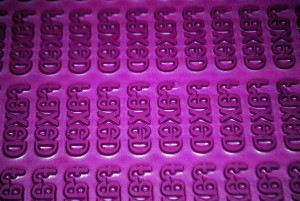Printing Surfaces Matter
 Can any ink print on any surface? The short answer is “NO”, certain inks adhere to certain types of surfaces more efficiently than others. The difference in an ink’s ability to adhere to a surface relies primarily on the porosity of the printing surface.
Can any ink print on any surface? The short answer is “NO”, certain inks adhere to certain types of surfaces more efficiently than others. The difference in an ink’s ability to adhere to a surface relies primarily on the porosity of the printing surface.
The measurement of a substrate’s porosity falls into one of two broad categories, either porous or nonporous. The technical definition of porous and nonporous substrates, along with examples
follows:
• Porous – substrates are made up of materials that have minute holes through which liquid or air may pass. These “holes” vary in diameter from microporous (2nm or less), mesoporous (2nm – 50nm) to macroporous (50nm or more). Typical materials that are considered porous are paper, cardboard, lumber/wood, etc. The diameter of the pores in your substrate will dictate the type of ink and viscosity of that ink that will need to be used in your printing application.
• Nonporous – substrates are made up of materials that do not have “holes” that allow liquids or air to pass through them. Types of nonporous materials are metals, glass and hard plastics. As with porous materials the substrate of nonporous materials will dictate the type of ink and viscosity that will be used during the printing process.
Determining the porosity of the substrate that you are working with, will allow you to plan for the appearance of the final printed image on that substrate. A general rule of thumb is that a smoother textured surface will result in a higher resolution image, while a courser-textured substrate will result in a lower resolution.
Properly matching the ink used in printing with the printing surface will help to alleviate many common industrial printing quality concerns. The resulting printed image will maintain the desired resolution ensuring proper distribution of materials, legible warning labels, correct material handling, and much more.
